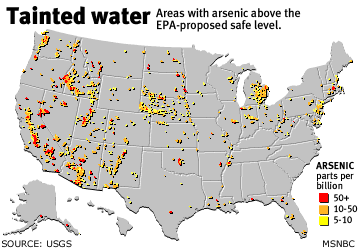 |
 |
| Tighter Standard on Arsenic in Water |
| An Environmentaltection Agency order reducing by 80 percent the allowable levels of arsenic in drinking water is being praised by environmentalists and endorsed by the water industry. While not quite as strict as some activists would have liked, the order won the support of water agencies, which urged Congress to help pay for the health improvements. The action updates a 60-year-old arsenic standard and is expected to require about 3,000 communities - generally small water systems - to make changes in the treatment of drinking water. Former President Bill Clinton, in a statement, praised the long-planned action for providing "additional public health protection for 13 million Americans". Environmentalists have argued for years that the asenic standard of 50 parts per billion should be tightened. Last year, the EPA proposed going to 5 parts per billion as |
| demanded by many environmentalists, but then settled at 10 parts per billion. The EPA estimated its new standard will increase the annual water bill $60 or less per household in communities where improved treatment and upgrades are needed. Some financial and technical assistance will be available for small systems needing to make improvements to meet the new standard. All 54,000 community water systems, serving about 254 million people, will be subject to the new standard. Only about 5%, or 3,000 systems serving 13 million people, will have to upgrade their systems to meet the new standard. Most of the systems affected by |
| the standard serve fewer than 10,000 people. Communities in parts of the Midwest and New England that depend on underground sources for drinking water will be affected the most. |
| Arsenic exposure can cause a variety of adverse effects. Acute high-dose oral exposure typically leads to gastrointestinal irritations and difficulty in swollowing, thirst, abnormally low blood pressure and convulsions. Death may occur from cardiovascular collapse at very high doses. For most people, the most significant route of exposure to araenic is through food since it is a normal component of diets. Studies by the Food and Drug Administration have found that fish and seafood are higher in arsenic content than any other foods. Arsenic concentrations are generally highest in groundwater. Surface water concentrations also may be at levels of regulatory concern. |
| Evidence exists that long-term exposure to high arsenic levels increases the risk of cancer. When exposure is by inhalation, the primary effect is increased risk of lung cancer. When exposure is by ingestion, the clearest effect is increased risk of skin cancer. Evidence also exists that the risk of internal cancer (liver, lung, bladder and kidney) is also increased through ingestion. Ingestion of drinking water can be a source of arsenic exposure. Several national surveys of drinking water systems have found arsenic in 3 to 39 percent of all samples averaging less than 10 parts per billion. |